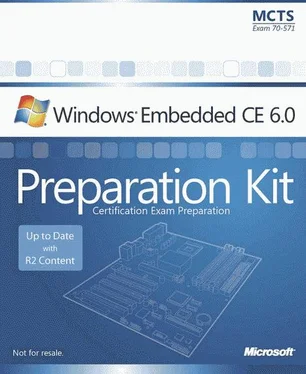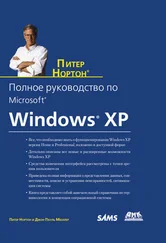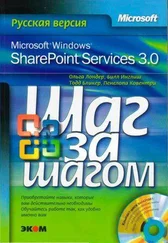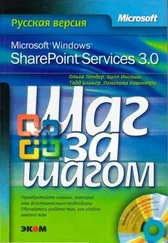Nicolas Besson - Microsoft Windows Embedded CE 6.0 Exam Preparation Kit
Здесь есть возможность читать онлайн «Nicolas Besson - Microsoft Windows Embedded CE 6.0 Exam Preparation Kit» весь текст электронной книги совершенно бесплатно (целиком полную версию без сокращений). В некоторых случаях можно слушать аудио, скачать через торрент в формате fb2 и присутствует краткое содержание. Город: Redmond, Год выпуска: 2008, Издательство: Microsoft, Жанр: Руководства, ОС и Сети, Программы, на английском языке. Описание произведения, (предисловие) а так же отзывы посетителей доступны на портале библиотеки ЛибКат.
- Название:Microsoft Windows Embedded CE 6.0 Exam Preparation Kit
- Автор:
- Издательство:Microsoft
- Жанр:
- Год:2008
- Город:Redmond
- ISBN:нет данных
- Рейтинг книги:5 / 5. Голосов: 1
-
Избранное:Добавить в избранное
- Отзывы:
-
Ваша оценка:
- 100
- 1
- 2
- 3
- 4
- 5
Microsoft Windows Embedded CE 6.0 Exam Preparation Kit: краткое содержание, описание и аннотация
Предлагаем к чтению аннотацию, описание, краткое содержание или предисловие (зависит от того, что написал сам автор книги «Microsoft Windows Embedded CE 6.0 Exam Preparation Kit»). Если вы не нашли необходимую информацию о книге — напишите в комментариях, мы постараемся отыскать её.
Microsoft Windows Embedded CE 6.0 Exam Preparation Kit — читать онлайн бесплатно полную книгу (весь текст) целиком
Ниже представлен текст книги, разбитый по страницам. Система сохранения места последней прочитанной страницы, позволяет с удобством читать онлайн бесплатно книгу «Microsoft Windows Embedded CE 6.0 Exam Preparation Kit», без необходимости каждый раз заново искать на чём Вы остановились. Поставьте закладку, и сможете в любой момент перейти на страницу, на которой закончили чтение.
Интервал:
Закладка:
Exam objectives in this chapter:
■ Building run-time images
■ Analyzing build results and build files
■ Deploying a run-time image on a target device
■ To complete the lessons in this chapter, you must have:
■ An understanding of operating system (OS) design aspects, including catalog items and the configuration of environment variables and SYSGEN variables, as explained in Chapter 1, "Customizing the Operating System Design."
■ At least some basic knowledge about Windows Embedded CE software development, including source code compilation and linking.
■ A development computer with Microsoft Visual Studio® 2005 Service Pack 1 and Platform Builder for Windows Embedded CE 6.0 R2 installed.
Lesson 1: Building a Run-Time Image
The Windows Embedded CE build process is the final step in the run-time image development cycle. Based on the settings defined in the OS design, Platform Builder compiles all components, including subprojects and the BSP, and then creates a runtime image that you can download to the target device. The build process entails several build phases, automated by means of batch files. You must understand these phases and the build tools if you want to configure build options correctly, create runtime images efficiently, and solve build-related issues.
After this lesson, you will be able to:
■ Understand the build process.
■ Analyze and fix build issues.
■ Deploy a run-time image to target hardware.
Estimated lesson time: 40 minutes.
Build Process Overview
The Windows Embedded CE build process includes four main phases, as illustrated in Figure 2-1. They follow each other sequentially, but you can also carry them out independently if you know the purpose and tools used for each phase. By selectively running the build tools, you can perform individual build steps in a targeted way, which helps to save build time and ultimately increases your efficiency.
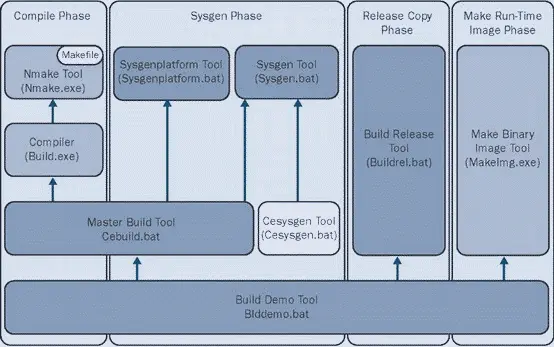
Figure 2-1Build phases and build tools
The build process includes the following key phases:
■ Compile phaseCompiler and linker use source code and resource files to generate executable (.exe) files, static (.lib) libraries, dynamic-link library (.dll) files, and binary resource (.res) files according to the selected locales. For example, the build system compiles the source code in the Private and Public folders into .lib files during this phase. This process can take several hours to complete, but fortunately it is seldom required to rebuild these components because binaries are already provided by Microsoft. In any case, you should not modify the source code in the Private and Public folders.
■ Sysgen phaseThe build system sets or clears SYSGEN variables based on the catalog items and dependency trees included in the OS design, filters the header files and creates import libraries for the Software Development Kits (SDKs) defined in the OS design, creates a set of run-time image configuration files for the OS design, and builds the BSP based on the source files in the Platform directory.
■ Build phaseThe build system processes the source files of your Board Support Package and applications using the files generated during the Sysgen phase. At this time, hardware-linked drivers and the OEM adaptation layer (OAL) are built. Although the processes during the build phase are carried out automatically during the Sysgen phase, it is important to understand that if you modify only the BSP and subprojects, then you can rebuild the BSP and subprojects without running the Sysgen tool again.
■ Release Copy phaseThe build system copies all files required to create the runtime image to the OS design's release directory. This includes the .lib, .dll, and .exe files created during the Compile and Sysgen phases, as well as binary image builder (.bib) and registry (.reg) files. The build system might skip this phase if headers and libraries are up-to-date.
■ Make Run-time Image phaseThe build system copies project-specific files (Project.bib, Project.dat, Project.db, and Project.reg) to the release directory and assembles all files in the release directory into a run-time image. Directives based on environment variables specified in .reg and .bib files control which catalog items the build system includes in the final run-time image. The run-time image is typically a file named Nk.bin, which you can download and run on the target device.
Building Run-Time Images in Visual Studio
During the installation of Windows Embedded CE 6.0 R2 on your development workstation, Platform Builder integrates with Visual Studio 2005 and extends the Build menu so that you can control the build process directly in the Visual Studio IDE. Figure 2-2 shows the Platform Builder commands that are available on the Build menu when you select the OS design node in Solution Explorer.
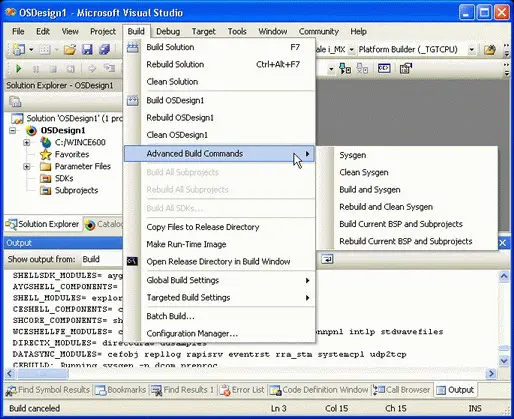
Figure 2-2Windows Embedded CE build commands in Visual Studio 2005
You can use the Platform Builder commands on the Build menu to perform selective build steps or a combined series of steps that span multiple build phases. For example, you can use the Copy Files To Release Directory command to ensure that the build system copies updated .bib and .reg files to the release directory even if header files and libraries have not changed. Otherwise, the build system skips the Release Copy phase and .bib file or .reg file changes are not applied to the run-time image.
Table 2-1 summarizes the purpose of the Windows Embedded CE build commands.
Table 2-1 Windows Embedded CE build and rebuild commands
| Menu Option | Description | |
|---|---|---|
| Build Solution | Equivalent to the Sysgen command on the Advanced Build Commands submenu. | |
| Rebuild Solution | Equivalent to the Clean Sysgen command on the Advanced Build Commands submenu. | |
| Clean Solution | Cleans the release directory by deleting all intermediate files. | |
| Build < OS Design Name > | Helpful in solutions that include multiple OS designs. In solutions with a single OS design, these options correspond to the Build Solution, Rebuild Solution, and Clean Solution commands. | |
| Rebuild > | ||
| Clean > | ||
| Advanced Build Commands | Sysgen | Runs the Sysgen tool and links the .lib files in the Public and Private folders to create the files for the run-time image. The files remain in the WinCE folder of the OS design. Depending on global build settings, the build process can automatically advance to the Release Copy and then Make Run-time Image phases. |
| Clean Sysgen | Cleans out intermediate files created during previous builds before running the Sysgen tool. Use this option if you added or removed files or catalog items after a previous Sysgen session to reduce the risk of build errors. | |
| Build And Sysgen | Compiles the entire contents of the Public and Private folders, and then links the files by using the settings in your OS design. This process takes several hours and is only necessary if you modified the contents of the Public folder. Unless you modify the Windows Embedded CE code base (not recommended), you should not use this option. | |
| Rebuild And Sysgen | Cleans out intermediate files created during previous builds in the Public and Private folders, and then runs the Build and Sysgen steps. You should not use this option. | |
| Build Current BSP And Subprojects | Builds the files in the directory for the current BSP and any subprojects in the OS design, and then runs the Sysgen tool. Note that this option will build other BSPs than the ones used in the current OS design, so make sure your BSPs are compatible with each other or remove unused BSPs. | |
| Rebuild Current BSP And Subprojects | Cleans out intermediate files created during previous builds, and then runs the Build Current BSP And Subprojects steps. | |
| Build All Subprojects | Compiles and links all subprojects, skipping any files that are up-to-date. | |
| Rebuild All Subprojects | Cleans, compiles, and links all subprojects. | |
| Build All SDKs | Builds all SDKs in the project and creates corresponding Microsoft Installer (MSI) packages. Because there is generally no reason to create debug versions of MSI packages, use this option only for a Release build configuration. | |
| Copy Files To Release Directory | Copies the files generated for the BSP and other components during the Compile and Sysgen phases to the release directory in order to include these file in the run-time image. | |
| Make Run-Time Image | Takes all the files in the release directory to create the run-time image. Following this step, you can download the run-time image to a target device. | |
| Open Release Directory In Build Window | Opens a Command Prompt window, changes into the release directory, and sets all necessary environment variables to run batch files and build tools manually. Use this to perform build steps at the command prompt. The standard Command Prompt window does not initialize the development environment to run the build tools successfully. | |
| Global Build Settings | Copy Files To Release Directory After Build | Enables or disables automatic advancement to the Release Copy phase for all commands. |
| Make Run-Time Image After Build | Enables or disables automatic advancing to the Make Run-time Image phase after any build operation. | |
| Targeted Build Settings | Make Run-Time Image After Build | Enables or disables the Make Run-time Image phase. |
| Batch Build | Enables you to perform multiple builds sequentially. | |
| Configuration Manager | Enables you to add or remove build configurations. |
The Advanced Build Commands submenu provides access to several Platform Builder-specific build commands that you might find useful on a regular basis. For example, you need to run the Sysgen or Clean Sysgen command when you add or remove catalog components to or from the OS design to create the binary versions for the run-time image. Exceptions to this rule are components that do not modify SYSGEN variables, such as components in the ThirdParty folder. It is not necessary to run Sysgen or Clean Sysgen when you select or deselect these items. Following the Sysgen phase, Platform Builder continues the build process similar to running the Build Current BSP And Subprojects command.
Читать дальшеИнтервал:
Закладка:
Похожие книги на «Microsoft Windows Embedded CE 6.0 Exam Preparation Kit»
Представляем Вашему вниманию похожие книги на «Microsoft Windows Embedded CE 6.0 Exam Preparation Kit» списком для выбора. Мы отобрали схожую по названию и смыслу литературу в надежде предоставить читателям больше вариантов отыскать новые, интересные, ещё непрочитанные произведения.
Обсуждение, отзывы о книге «Microsoft Windows Embedded CE 6.0 Exam Preparation Kit» и просто собственные мнения читателей. Оставьте ваши комментарии, напишите, что Вы думаете о произведении, его смысле или главных героях. Укажите что конкретно понравилось, а что нет, и почему Вы так считаете.
